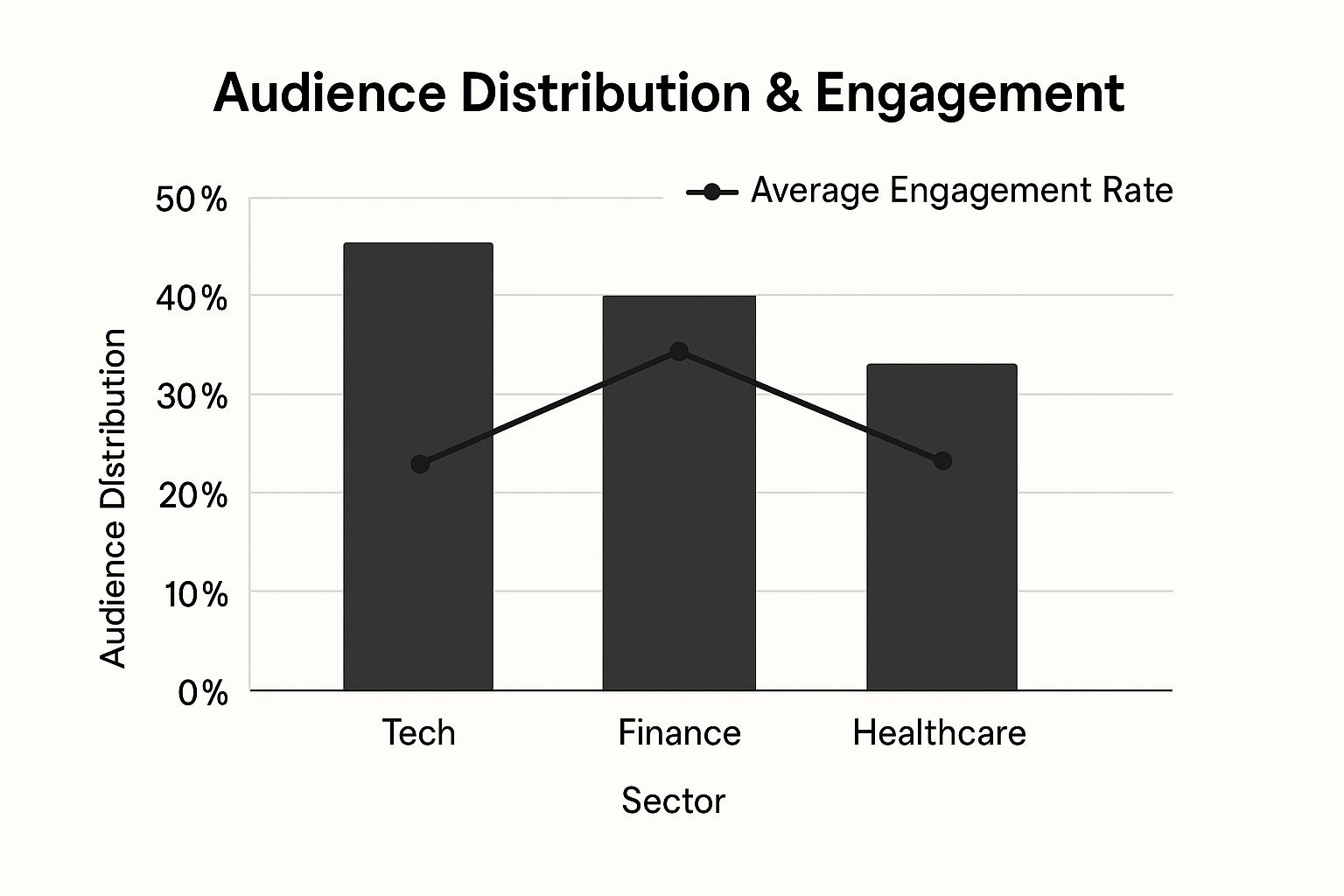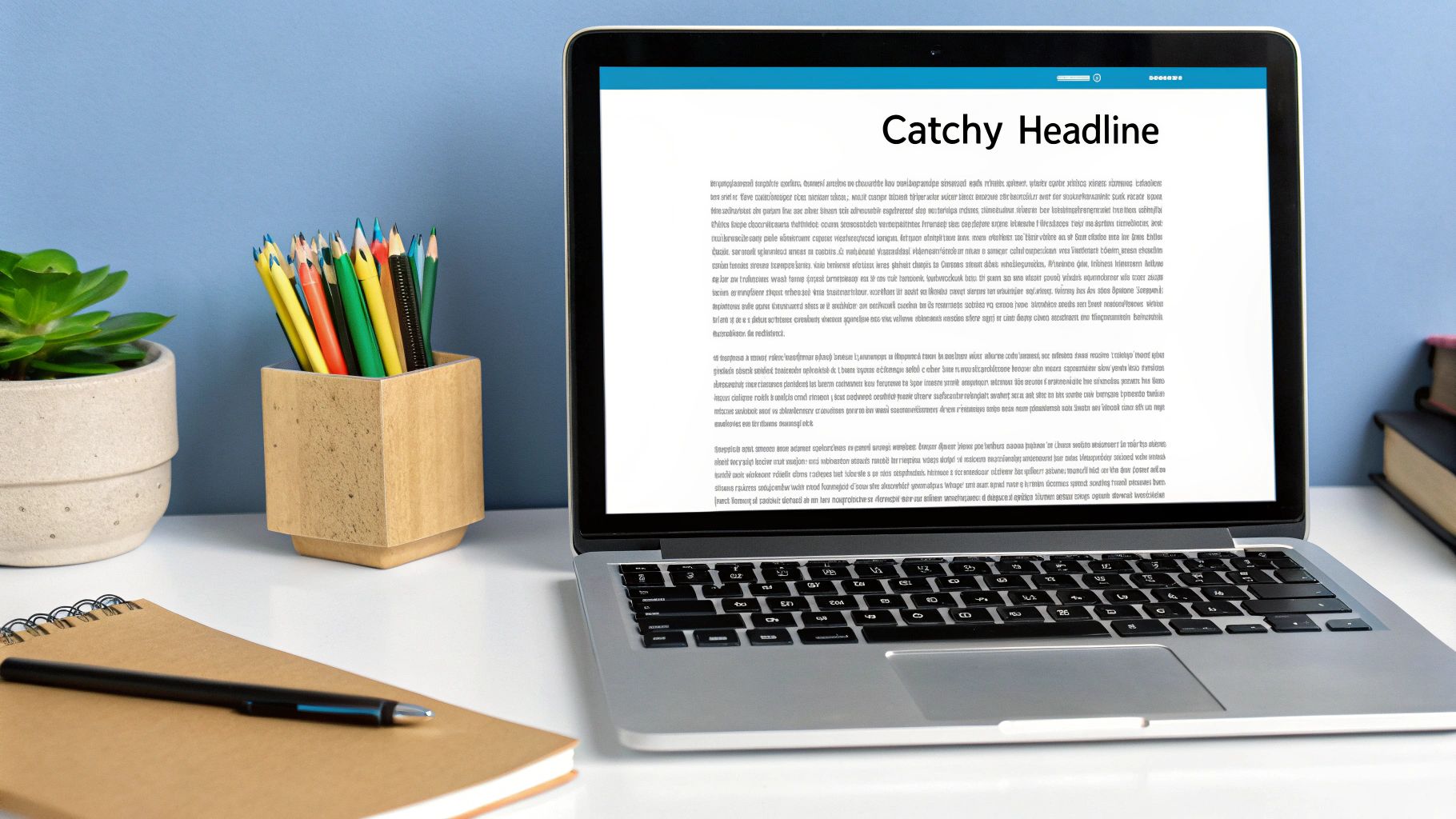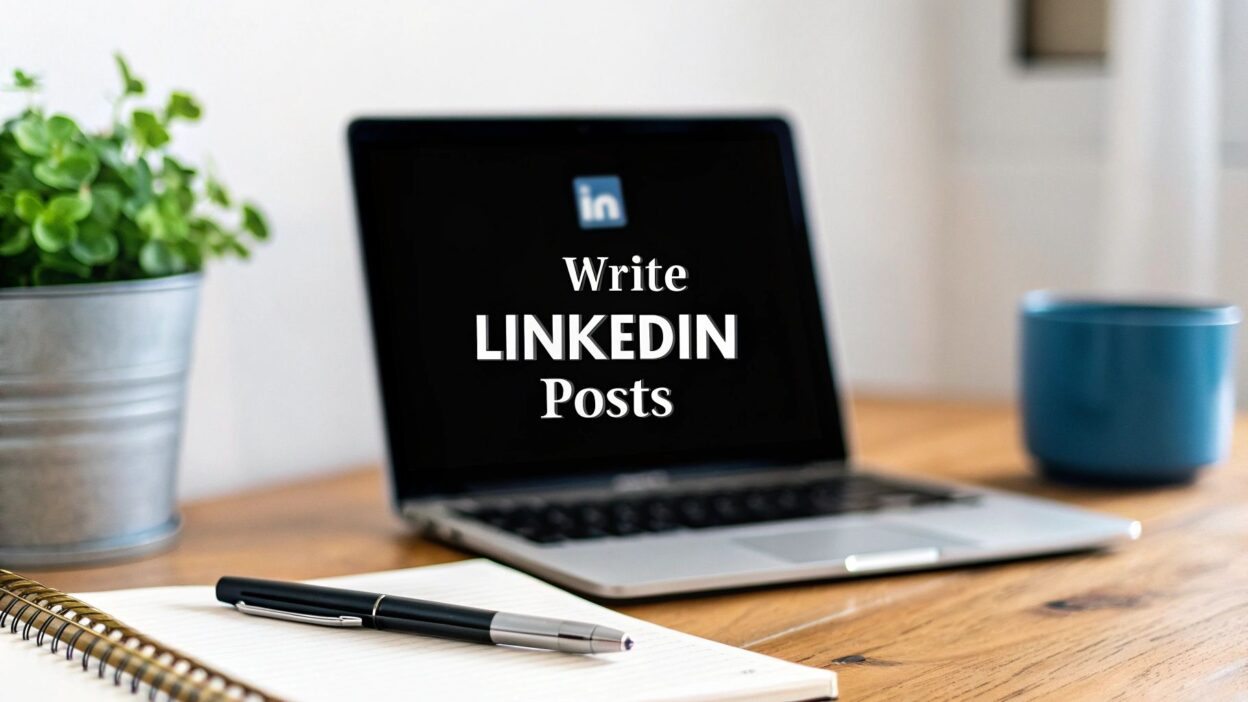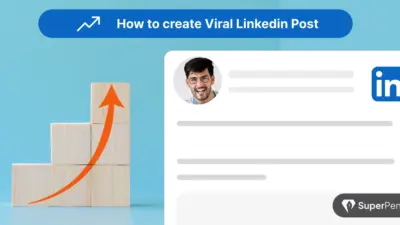Decoding LinkedIn’s Unique Engagement Ecosystem

The infographic above illustrates audience distribution and average engagement rates across three key sectors: Tech, Finance, and Healthcare. Interestingly, while Tech holds the largest audience share, Healthcare boasts a significantly higher average engagement rate. This tells us that while a broad reach is good, targeted content within a niche can generate stronger engagement on LinkedIn. This is a fundamental principle for anyone looking to write effective LinkedIn posts.
Understanding the Professional Mindset
LinkedIn isn’t like Instagram or Twitter. It’s a platform driven by professional connection and growth. Users engage with content that offers value to their careers, expands their industry knowledge, or strengthens their professional network. Understanding this professional psychology is key to creating posts that resonate. Actionable insights, industry trends, and career advice tend to perform well, while purely personal updates often fall flat. For more tips on crafting compelling LinkedIn content, check out our blog post: How to master the art of LinkedIn posting on our blog.
The Power of Engagement on LinkedIn
LinkedIn offers a powerful way for businesses and professionals to connect with their target audience. With approximately 310 million monthly active users as of 2025, and around 134.5 million logging in daily, the potential for reach is immense. Typical engagement rates fall between 2.8% and 3.8%. However, incorporating multimedia, especially video, can significantly boost these numbers. Video content, in fact, receives five times more engagement than text-only posts. For a deeper dive into LinkedIn statistics, visit: LinkedIn Statistics.
Decoding the Algorithm
LinkedIn’s algorithm prioritizes content that sparks meaningful conversations and builds genuine connections. Therefore, creating posts that encourage comments, shares, and likes is crucial. The algorithm also favors content from individuals and companies with whom users actively engage. This highlights the importance of fostering a strong, interactive network. Understanding these nuances is vital for maximizing your posts’ visibility and impact.
Let’s explore how different content formats perform on LinkedIn:
To help illustrate this, the table below provides a comparison of engagement rates across different content types:
LinkedIn Engagement Rates by Content Type
A comparison of how different content formats perform on LinkedIn in terms of engagement metrics
| Content Type | Average Engagement Rate | Comment Rate | Share Rate | Best Use Case |
|---|---|---|---|---|
| Text Posts | 1.5% – 2.5% | Moderate | Low | Sharing quick updates, asking questions |
| Image Posts | 2.0% – 3.0% | Moderate | Moderate | Visual storytelling, showcasing data |
| Video Posts | 3.5% – 4.5% | High | High | Sharing insights, behind-the-scenes looks |
| Article Posts | 2.5% – 3.5% | Moderate | High | Thought leadership, in-depth analysis |
| Document Posts (Carousels) | 3.0% – 4.0% | High | Moderate | Sharing multiple pieces of information, step-by-step guides |
As you can see, different content types offer varying levels of engagement. Experimenting with different formats is key to finding what works best for your audience.
Building an Effective LinkedIn Strategy
A successful LinkedIn strategy should be data-driven and tailored to your audience. This includes understanding the best times to post, the ideal posting frequency, and the formats that resonate most. Posting during business hours, particularly mid-morning and lunchtime, often yields higher visibility. Consistently providing valuable content builds your credibility and strengthens your industry presence. These insights are crucial for crafting LinkedIn posts that deliver results.
Crafting First Lines That Stop Professional Scrollers

The LinkedIn feed moves fast. It’s a whirlwind of updates, articles, and career changes. To make your content stand out, your first line needs to grab attention and stop professionals mid-scroll. Think of it as a compelling headline in a busy newsfeed.
The Psychology of the Scroll
Why the constant scrolling? People are busy. Their feeds are overflowing. They’re searching for information relevant to their careers. Your first line must address this directly. It’s your first impression, a chance to connect with your audience and encourage them to read more.
Frameworks for Compelling Openings
Several frameworks can help you craft captivating first lines. One effective method is the three-part hook.
- The Problem/Question: Begin by highlighting a common challenge your audience faces. Example: “Is your LinkedIn content getting lost in the noise?”
- The Intrigue/Promise: Suggest a solution or valuable insight. Example: “Learn three proven tactics to amplify your LinkedIn engagement.”
- The Call to Action (subtle): Gently encourage further reading. Example: “Discover how to create posts that spark conversations.”
From Bland to Grand: Real-World Examples
Compare this weak opening: “Sharing my marketing thoughts.” Now look at a stronger alternative: “Frustrated with low engagement on your marketing posts? Here’s the hidden reason why.” The second example uses the three-part hook to immediately grab attention and address a specific pain point.
Understanding Your LinkedIn Audience
Knowing your audience is key. LinkedIn demographics and content consumption patterns offer valuable insights. For example, LinkedIn’s largest user group is aged 25 to 34. Most users consume content to stay updated on industry news (78%) and discover new ideas (73%). Images significantly boost engagement, with image posts receiving 98% more comments. Find more detailed statistics here.
Common Mistakes to Avoid
Avoid generic statements, jargon, and overly promotional language. Starting with “I’m excited to announce…” or focusing solely on your company is a surefire way to lose your audience. Focus on providing value to the reader. This builds trust and positions you as a resource within their professional network.
By understanding your audience and focusing on their needs, your LinkedIn posts will stand out from the crowd. Consistently applying these principles will transform your content from easily scrolled past to conversation starters.
The Architecture of High-Converting LinkedIn Content

What makes some LinkedIn posts vanish into the feed while others ignite discussions and boost business? It’s all in the content architecture. It’s not just what you share, but how you structure it for maximum impact. Like an architect designing a building, you need to strategically construct your LinkedIn posts.
The Science of Optimal Length
Many believe longer equals more engagement. Research shows this isn’t always true. While in-depth articles have their place, LinkedIn users often appreciate easily digestible content.
Aim for a length that delivers value without overwhelming readers. This sweet spot is typically 500-800 words for articles, and shorter for standard posts. A concise post with one key takeaway can outperform a long, rambling one.
Paragraph Sequencing and White Space
Compelling storytelling relies on pacing and pauses. Your LinkedIn posts need rhythm too. Short paragraphs (2-4 sentences) maintain reader interest.
Using white space strategically makes content visually appealing and scannable. Think of it as interior design: too much furniture feels cluttered, too little feels empty. Balance is key for holding your audience’s attention.
Storytelling for Professional Credibility
Facts and data are important, but human connection is crucial on LinkedIn. Weaving in personal anecdotes and relatable experiences boosts engagement.
This isn’t about oversharing. It’s about showcasing your expertise through real-world examples. Sharing a brief story about overcoming a professional challenge builds trust and credibility.
Calls to Action That Feel Helpful
Many LinkedIn posts fall flat because their calls to action are pushy or salesy. Instead of directly pitching your product or service, focus on providing value.
Ask questions, invite comments, and spark discussion. This cultivates engagement and nurtures relationships. Then, any eventual call to action feels natural, not intrusive.
The Structure of a High-Converting Post
Craft compelling first lines using tools like a LinkedIn Headline Generator. This grabs attention from the start. For the rest of your post, consider this framework:
To better understand how to structure a high-converting LinkedIn post, let’s look at the table below. It breaks down the key components, their purpose, best practices, and provides a practical example for each.
| Component | Purpose | Best Practice | Example |
|---|---|---|---|
| Hook | Grab the reader’s attention | Start with a question, a bold statement, or a surprising statistic. | “Are you tired of your LinkedIn posts getting lost in the noise?” |
| Context | Set the stage for the main point | Briefly explain the problem or topic you’re addressing. | “LinkedIn’s algorithm can be tricky to navigate.” |
| Value/Insight | Deliver the core message of your post | Share valuable information, actionable advice, or a unique perspective. | “Here are three proven strategies to boost your LinkedIn visibility.” |
| Example/Story | Make the information relatable and memorable | Illustrate your point with a real-world example or a personal anecdote. | “I used this technique to increase my engagement by 20%.” |
| Call to Action | Encourage engagement and further interaction | Ask a question, invite comments, or suggest a next step. | “What strategies have worked for you? Share your tips below!” |
This table provides a simple yet powerful framework. By following these components, you can ensure your posts are engaging and drive the desired results.
By applying these principles, your LinkedIn posts become powerful engagement magnets, not forgotten updates. The architecture of your content is key to its success.
Format Mastery: Maximizing Each LinkedIn Content Type
Choosing the right format for your LinkedIn posts is crucial for success. Just like selecting the correct tool for a job, different LinkedIn formats offer unique advantages. Understanding these nuances can significantly maximize your impact.
The Power of the Carousel
Carousel posts are essentially slide decks within LinkedIn. They allow you to break down complex information into digestible, visually appealing chunks. This format offers a dynamic way to tell multi-part stories, showcase product features, or present data. Carousels consistently outperform static image posts, often generating significantly more engagement.
Polls: Sparking Meaningful Discussion
Polls offer a powerful way to interact with your audience and gain valuable insights. The key is to ask strategic questions. Avoid simple yes/no queries. Instead, pose thought-provoking questions that encourage discussion and reveal valuable audience perspectives. This fosters a sense of community and positions you as a thought leader.
Video: Optimizing for LinkedIn’s Viewing Habits
Video continues to be a highly engaging format. However, optimizing for LinkedIn’s specific viewing habits is essential. Many users scroll through their feed with their sound off. Therefore, adding captions to your videos is vital for conveying your message effectively. Keep videos concise and front-load key information to capture attention quickly. For those looking to download videos, resources like How to master video downloading for LinkedIn can be helpful.
Document Posts: The Unexpected Champion
Document posts, which allow you to upload PDFs, presentations, and other rich media directly to LinkedIn, are often overlooked. This format allows for in-depth content sharing and presents a polished, professional image. It’s an excellent option for sharing white papers, research reports, or detailed case studies that showcase your expertise.
Choosing the Right Format for Your Goals
Strategic format selection is crucial for achieving your objectives. For lead generation, consider using carousel posts to highlight product features and benefits. For relationship building, polls and video content can spark conversation and foster a sense of community. Understanding these nuances enables you to choose the most effective format for every message.
Format-Specific Templates and Examples
This table offers a quick guide to choosing the best format for your LinkedIn content:
| Content Type | Best Use Case | Example |
|---|---|---|
| Text Post | Short updates, announcements, quick questions | Sharing an industry article with a brief comment |
| Image Post | Visual storytelling, sharing infographics, highlighting quotes | Posting an inspiring image with a motivational caption |
| Video Post | Sharing insights, demonstrating a product, giving a short presentation | A quick tip video about LinkedIn best practices |
| Carousel Post | Step-by-step guides, showcasing multiple product features, data visualization | A carousel explaining how to use a new LinkedIn feature |
| Poll Post | Gathering audience opinions, sparking discussions, conducting market research | Asking your audience which marketing strategy they prefer |
| Document Post | Sharing in-depth reports, white papers, presentations | Uploading a PDF case study outlining a successful marketing campaign |
By strategically selecting the right format, your LinkedIn posts will resonate with your target audience and achieve your desired outcomes. Remember that variety is essential. Experiment with different content types to see what works best. Understanding the strengths of each format helps you create engaging posts that capture attention and build your professional brand.
Developing Your Professional Voice That Stands Out
Finding your unique voice on LinkedIn is about balancing professionalism and authenticity. It’s about showcasing your expertise while connecting with your audience personally. Think of it as networking – you want to present your best self while remaining approachable and engaging.
Overcoming Psychological Barriers
Many professionals hesitate to post consistently due to imposter syndrome or fear of criticism. Feeling vulnerable when sharing online is normal. However, these fears often come from a misconception that LinkedIn is only for flawless self-promotion. The truth is, LinkedIn thrives on genuine connection and open dialogue. It’s a place to embrace imperfections and learn from shared experiences.
Discovering Your Unique Perspective
Your unique perspective is your biggest strength on LinkedIn. Nobody else has your exact experiences or views. Identify what differentiates you in your field. What unique insights can you offer? Maybe you have a unique approach to problem-solving or a distinct way of understanding industry trends. Embrace these differences. They are the core of your authentic voice.
Sharing Personal Experiences Appropriately
While LinkedIn is professional, relevant personal experiences can enrich your content and make it relatable. Sharing a short story about overcoming a challenge or a career-changing “aha” moment adds a human touch and builds trust. However, always maintain professionalism. Think of these stories as adding flavor, not the main dish.
Expressing Opinions with Confidence and Inviting Dialogue
Sharing opinions on LinkedIn can establish you as a thought leader, but do so constructively. Support your claims with evidence, present your perspective thoughtfully, and invite respectful discussion. Asking open-ended questions encourages engagement and builds community. This creates a dynamic exchange of ideas, making you a valuable contributor.
Building Authority Through Consistent Content
Building authority on LinkedIn takes time and consistency. It’s like building a reputation offline—a gradual process of demonstrating your knowledge and expertise. Consistently sharing insights, engaging in meaningful discussions, and offering helpful advice gradually establishes you as a trusted voice. SuperPen can help with its AI-driven content creation tools, offering over 200 templates and inspiration from millions of top posts. This helps you overcome writer’s block and maintain a regular posting schedule, building a stronger presence and achieving your goals. With SuperPen’s intuitive platform and free access to essential features, learn how to streamline your LinkedIn growth.
Strategic Timing: When and How Often to Post
Timing is crucial for successful LinkedIn posts. Even the most engaging content can be overlooked if posted at the wrong time. Understanding your audience’s online habits is key to maximizing visibility and engagement.
The Psychology of the Workweek
Think about the typical flow of the workweek. Mondays are usually busy as people catch up after the weekend. Fridays often see a dip in engagement as people prepare for the weekend. This makes Tuesdays, Wednesdays, and Thursdays ideal for posting. Data supports this, showing peak LinkedIn activity mid-morning and during lunch breaks. These are the times when professionals often pause to check their feeds and interact with content.
Finding Your Ideal Posting Cadence
How often should you be posting? The magic number depends on several factors. First, consider your content creation capacity. Quality over quantity reigns supreme. A sustainable posting schedule prevents burnout and keeps your content valuable.
Experiment to find what works for you. Maybe start with two to three posts per week and adjust based on your results. Try varying posting times on those days to see which generates the most interaction.
Testing Different Posting Times
Testing and analysis are essential. LinkedIn‘s analytics offer invaluable data on post performance. Analyze key metrics like impressions, likes, comments, and shares. Experiment with different posting times and content formats to see what resonates best with your audience. Check out our guide on maximizing your LinkedIn content with SuperPen’s pricing plans.
Maintaining Consistency Despite Time Constraints
Consistent posting cultivates a loyal audience. But maintaining a regular schedule can be a challenge. A practical solution is content batching. Dedicate time each week to create several posts in advance. This allows you to maintain a consistent presence, even during busy periods.
Creating Sustainable Posting Rhythms
A consistent posting schedule requires a strategic approach. Consider these tips:
- Plan ahead: Create a content calendar outlining topics and posting dates.
- Repurpose content: Adapt existing blog posts, articles, or presentations for LinkedIn.
- Use templates: Pre-designed templates can streamline your content creation process.
By strategically scheduling and repurposing content, you maintain consistency without sacrificing quality. These sustainable posting rhythms will help you achieve your LinkedIn objectives without burning out. Remember, consistent, quality content is more effective than a high volume of low-quality posts. Focus on providing valuable content regularly to establish yourself as a resource for your audience.
Measuring What Matters: Analytics That Drive Growth
Gone are the days when simply counting likes and shares told the whole story. Truly understanding how your LinkedIn posts perform requires a deeper look into the metrics that really move the needle. These key metrics can change depending on your goals, whether you’re aiming to become a thought leader, generate leads, or expand your network.
Identifying Key Performance Indicators (KPIs)
Different objectives call for different KPIs. If you’re working to establish yourself as a thought leader, focus on metrics like comments and shares. These show how well your content resonates and sparks discussion. For lead generation, keep a close eye on click-through rates on any links you include in your posts. If expanding your network is your priority, then monitor connection requests and follower growth.
Using LinkedIn’s Native Analytics
LinkedIn offers built-in analytics that provide helpful insights into post performance. You can access information on impressions, clicks, likes, comments, shares, and engagement rate. This data illuminates what’s working and what’s not. Don’t forget to pay close attention to the dwell time metric. This tells you how long users spend reading your posts. Longer dwell times usually mean your content is holding their attention.
Complementary Measurement Tools
While LinkedIn’s native analytics are valuable, some third-party tools provide a deeper level of analysis. Certain tools allow you to see mentions of your brand or name across LinkedIn, giving you a wider perspective of your online presence. Others offer competitor analysis, allowing you to compare your performance to industry leaders.
Setting Realistic Benchmarks
Comparing your progress to others can be a great motivator, but setting realistic benchmarks is essential. Your network size, industry, and content type all affect your results. A smaller network will likely have fewer impressions than a larger one, which is perfectly normal. Strategic timing is also crucial for LinkedIn posts. You can learn more about optimal posting times from this article on best time to send marketing texts. Concentrate on making gradual improvements instead of expecting instant success.
A/B Testing for Continuous Refinement
A/B testing is a useful method for optimizing your LinkedIn posts. Try out various headlines, visuals, and calls to action. By comparing the performance of two different versions of a post, you can pinpoint which elements resonate most with your audience. This data-driven approach encourages ongoing improvement and helps you make the biggest impact.
Handling Underperforming Content
Not every post will be a home run, and that’s perfectly acceptable. Look at underperforming content as an opportunity to learn. Analyze the data to see why a post didn’t perform as expected. Was the timing not ideal? Was the topic not relevant to your audience? Gain valuable knowledge from these experiences and use it to refine your future posts.
By focusing on the right metrics, analyzing the data, and constantly refining your approach, you can transform your LinkedIn presence from a passive activity into a powerful tool for professional growth. SuperPen offers AI-powered tools and proven templates to help you create engaging posts. From inspiration drawn from millions of top-performing posts to seamless LinkedIn integration, SuperPen helps you overcome writer’s block, maintain consistent posting, and boost engagement.





